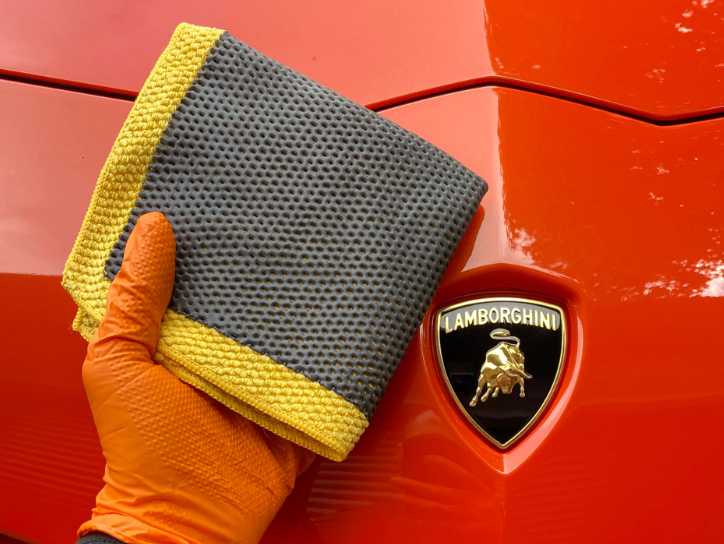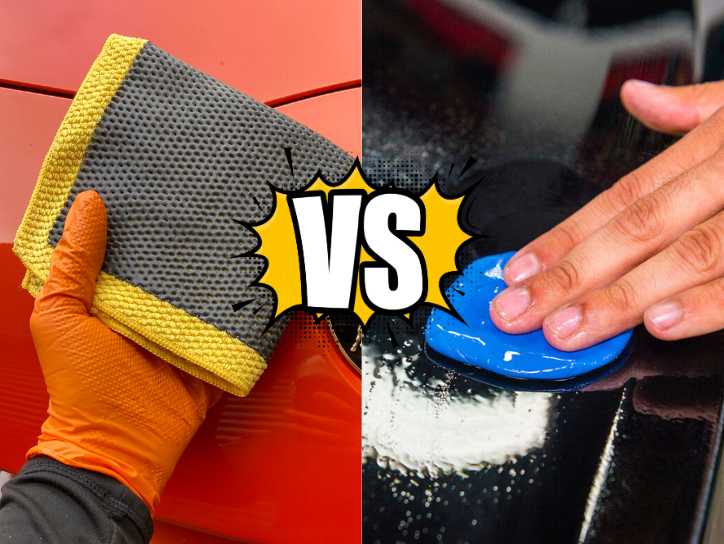Clay towels and clay bars are detailing tools designed to remove contaminants from a vehicle’s paint surface.
Clay towels are typically made from a synthetic material embedded with clay particles, while clay bars are solid blocks of clay. Below is a quick comparison:
| Aspect | Clay Towel | Clay Bar |
| Composition | Synthetic microfiber or foam with embedded clay particles | Solid block made of natural clay and synthetic additives |
| Application | Gently glide over the lubricated surface | Knead and flatten before gliding over the lubricated surface |
| Ease of Use | More user-friendly, suitable for beginners | Requires more skill and practice |
| Efficiency | Covers larger areas quickly | May take longer, especially in heavily contaminated areas |
| Effectiveness | Effective on less contaminated surfaces | More effective on heavily contaminated surfaces |
| Durability | Less durable compared to clay bars | Generally more durable and reusable |
| Cost | More affordable initially, shorter lifespan | Higher upfront cost, longer lifespan |
| Versatility | Suitable for larger surface areas and quick use | Different levels of aggressiveness for various needs |
| Maintenance | Requires proper care to maintain effectiveness | Needs proper kneading and inspection for contaminants |
| User Skill | Beginner-friendly | Requires more skill and experience |
| Recommended for | Less contaminated surfaces, beginners | Heavily contaminated surfaces, experienced users |
Clay Towel

A clay towel is a synthetic piece of cloth infused with clay particles, used in car detailing to remove contaminants from the paint surface quickly and efficiently.
Application Process: Using a clay towel involves lubricating the surface with a detailing spray and gently gliding the clay towel over the paint. The synthetic material offers flexibility and is less likely to be dropped compared to a clay bar.
Pros and Cons
Pros:
- Easier to handle for beginners
- Less prone to dropping
- Can cover larger surface areas quickly
Cons:
- May not last as long as clay bars
- Some enthusiasts argue that they may not be as effective on heavily contaminated surfaces
Clay Bar

Clay bars are solid, malleable blocks made from a combination of natural clay and synthetic additives. They come in various levels of aggressiveness to suit different decontamination of a vehicle.
Application Process: Use a clay bar, it needs to be kneaded and flattened before gliding it over a lubricated surface. This process requires a bit more effort and skill compared to a clay towel.
Pros and Cons
Pros:
- Can be more effective on heavily contaminated surfaces
- Generally more durable
- Comes in different levels of aggressiveness
Cons:
- More prone to being dropped
- May take longer to cover large surface areas
- Requires more skill, especially for beginners
Key Differences
- Efficiency and Speed: Clay towels are often praised for their efficiency and speed, allowing users to cover larger areas quickly. In contrast, clay bars may require more time and effort, especially on highly contaminated surfaces.
- Ease of Use: Clay towels are generally considered more user-friendly, making them suitable for both beginners and experienced detailers. On the other hand, clay bars require a bit more skill and practice to achieve optimal results.
- Durability: Clay bars are typically more durable and can be reused more often than clay towels. This longevity can make them more cost-effective in the long run.
- Cost: Clay towels are often more affordable initially, but their lifespan may be shorter. Clay bars, while more expensive upfront, can last longer and provide better value over time.
When to Choose a Clay Towel?
- If you are a beginner looking for an easy-to-use option
- When working on less contaminated surfaces
- If you need to cover large areas quickly
When to Choose a Clay Bar?
- For heavily contaminated surfaces that require more aggressive decontamination
- If you have experience and confidence in using detailing tools
- When looking for a more durable and cost-effective option in the long run
Also read:
Tips for Effective Application for Both Products
- Always use a quality detailing spray for lubrication
- Keep the surface well-lubricated to prevent marring
- Work in small sections for thorough decontamination
- Inspect the clay regularly for contaminants and knead or fold to expose a clean surface
Maintenance and Storage
Proper maintenance and storage are crucial to ensure the longevity of your clay towel or clay bar. To maximise their effectiveness, you should follow the manufacturer’s recommendations for cleaning and storing these tools.
FAQs
Which is considered more user-friendly for beginners, a clay towel, or a clay bar?
A clay towel is generally considered more user-friendly for beginners due to its ease of use and forgiving application process.
In terms of efficiency, which one covers larger surface areas more quickly – a clay towel or a clay bar?
A clay towel is known for its efficiency in covering larger surface areas quickly, making it a preferred choice for users who prioritize speed.
Which one is recommended for heavily contaminated surfaces – a clay towel or a clay bar?
A clay bar is often recommended for heavily contaminated surfaces, as its solid composition and different levels of aggressiveness make it more effective in such situations.
Can clay towels be reused, and how does their durability compare to clay bars?
While clay towels can be reused, they are generally less durable than clay bars. Clay bars tend to last longer and can be used for multiple detailing sessions.
What role does lubrication play in the effectiveness of both clay towels and clay bars?
Lubrication is crucial for both tools. It prevents marring and ensures smooth gliding over the surface, enhancing the effectiveness of both clay towels and clay bars.
In terms of storage, do clay towels and clay bars require any special considerations?
Proper storage is essential for both. Clay towels should be kept clean and dry, while clay bars should be stored in an airtight container to prevent them from drying out and becoming less effective over time.
Conclusion
Both clay towels and clay bars have their pros and cons, and the choice between them depends on your specific needs and preferences.
Consider factors such as the level of contamination, your detailing skill level, and your budget when making a decision.
Whether you opt for the ease of a clay towel or the versatility of a clay bar, regular decontamination will contribute to a stunning, well-maintained vehicle finish.
Hope you liked the comparison. Don’t forget to drop your questions and suggestions in the comment section given below.

